The women's jumper has long been an integral part of a basic wardrobe. Nowadays, almost any girl can knit such a pullover on her own, using simple patterns and step-by-step descriptions.
Fashionable styles of women's jumpers
This season, all famous couturiers have offered women a huge selection of fashionable jumpers in different shades and styles.
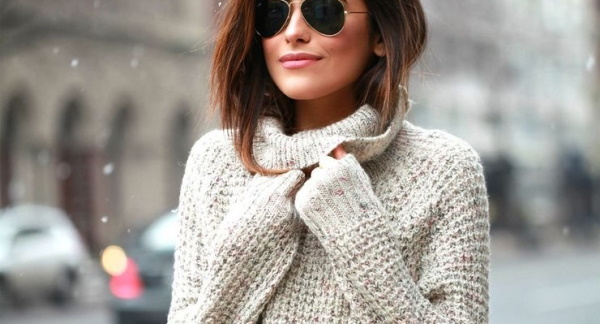
The trend is for plain, printed items of smooth or textured knitting. These are classic or oversized models in neutral and bright colors.
Basic
A snow-white loose-fitting garment with dropped shoulders is a versatile option for everyday wear. This model looks stylish with thick skirts, classic trousers or jeans. A thin jumper in a dark blue shade is another style for every day. This model easily fits into everyday and business looks. Stylists advise wearing it with a jacket, leather trousers. Or wear it with jackets and "bananas".
Oversized
A loose-fitting jumper in a neutral tone looks very stylish. It can be worn with trousers or jeans. It goes well with an elongated shirt or a textured knit cardigan.

A large melange jumper is perfect for creating minimalist, cozy looks. Wear joggers or wide knit pants underneath, and throw a fur coat over it. A long scarf and insulated winter sneakers with thick soles will complete the look.
With floral print
This pattern is always in trend. It goes well with different styles of clothing. A jumper decorated with a floral pattern like embroidery looks beautiful.
A knitted garment with a watercolor floral pattern looks very gentle and refreshes the image. The jumper can be decorated with a laconic brooch trimmed with pearls.
With geometric patterns
Patterned jumpers and sweaters are incredibly trendy this season. Designers call the item with the "rhombus" pattern a favorite. The model is ideal for a white shirt, leather trousers and a tweed bag.
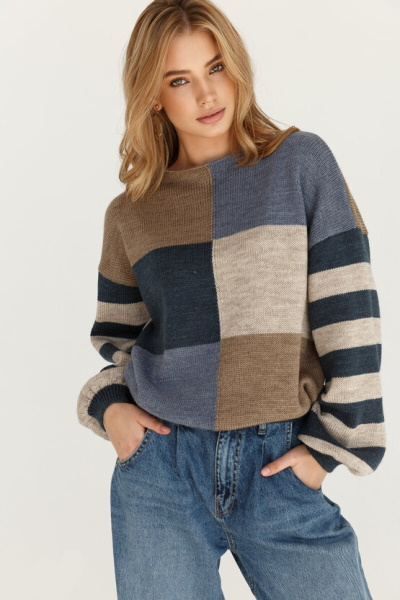
The argyle print is also in fashion. It is especially relevant this winter. This item is worn with a shirt with a turn-down collar, high-waisted sand-colored banana trousers. A tweed miniskirt and jockey-style boots will make the look more romantic.
With raglan sleeve
A stylish jumper fits easily into everyday outfits. Leather or wide knitted trousers will suit it. Joggers, jeans, and long straight skirts will look good. Shoes with high block heels will complete the look.
Textured knit jumper
A knitted women's jumper (the patterns and descriptions presented in the article will help you create a unique item) with interesting patterns looks incredibly stylish. The braided model is especially relevant - designers call it a hit of the winter season. The voluminous ornament will add texture to the look, making it more complex. Such a jumper will perfectly complement a white shirt, jeans, trousers made of thick fabric.
Jumpers in bright colours
Such items fit organically into different clothing styles. For example, joggers, strict skirts, and knitted trousers are worn under them. And golden decorations will highlight the bright colors of these jumpers.
With voluminous sleeves
Puffy sleeves really decorate the jumper, especially if it is a laconic model. The product is combined with skirts that add volume to the hips, "bananas". The silhouette is very expressive.

If you need to balance out a voluminous top, choose a tight skirt or tapered trousers and jeans.
Striped jumpers
Stylists call the striped pattern neutral, and therefore they believe that it combines well with other prints. Such a jumper is worn under two-piece suits, cardigans, vests. They are worn with denim jackets and straight corduroy trousers.
Suitable types of yarn for knitting jumpers
Women's jumpers or pullovers are made with knitting needles from any yarn. You just need to carefully study the patterns and description of the manufacture of products.
Yarn can be of many different types, for example:
- wool;
- angora;
- alpaca;
- merino;
- mohair;
- mink down.

Threads can vary in thickness. A thick thread and a set of knitting needles of the corresponding number are suitable for bulky knitting. Then the product is knitted without openwork. Warm jumpers are also knitted from thick threads, the main thing is that their composition includes wool. Then it is permissible to knit openwork patterns. Pullovers knitted from mohair with an openwork ornament look very feminine. They are weightless, delicate, and warm well in any cold weather.
Construction of a pattern, calculations for knitting
A women's jumper with knitting needles (the patterns and description of knitting may differ, but the rules for constructing patterns are the same for all models) can be knitted in a few days. However, measurements are taken first, a pattern of the model is constructed so that the product fits well on the figure.

First you need to prepare the tools:
- sheet of paper;
- pencil or pen;
- measuring tape.
Parameters:
| Abbreviations | Names of measurements | How to measure |
| OG | Chest circumference | The tape is placed horizontally at the level of the armpits. It is wrapped around the body, capturing the highest points of the chest. The ends are connected. |
| OSH | Neck circumference | The ribbon is wrapped around the neck, meeting at the dimple in front. |
| FROM | Waist circumference | It is belted with a centimeter-thick tape. |
| ABOUT | Hip circumference | Measure at the desired length of the jumper. Wrap the tape around your hips without tension. |
| OR | Arm circumference | Two measurements are taken. One at armpit level, the other at the narrowest point of the wrist. |
| SHS | Back width | The measurement is taken twice. From shoulder to shoulder + between the armpits. Both values are added together. The result is divided by 2. |
| DS | Back length | Measure the distance from the 7th cervical vertebra to the waist line. |
| DR | Sleeve length | The arm is lowered to take measurements from the shoulder joint to the required lower point. |
| DP | Shoulder length | Measure the distance from the base of the neck to the shoulder joint. |
| DI | Length of product | The tape is placed between the 7th cervical vertebra and the level of the required length of the jumper. |
| OZ | Wrist circumference |
A small measurement error is permissible – approximately 0.5 cm.
Construction of the pattern
Experienced knitters advise making a life-size drawing so that the pattern is convenient to work with. A rectangle is drawn on the sheet. Its height is equal to the "DI" measurement, and its width is ½ the "OG" measurement.
Example:
| Measure | Indicator |
| SHS | 32 cm |
| OG | 88 cm |
| DI | 56 cm |
| OSH | 33 cm |
| DR | 55 cm |
| OZ | 18 cm |
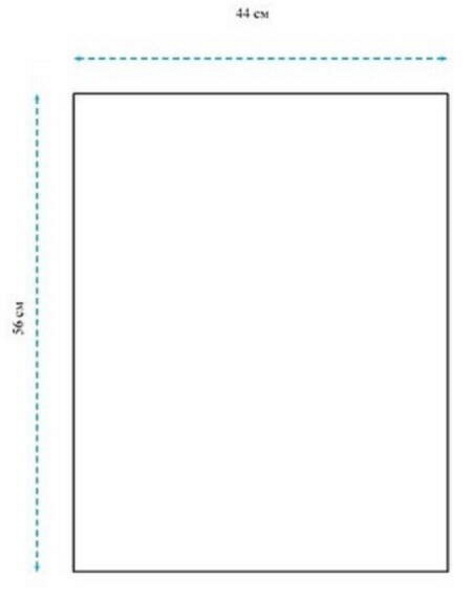
Construction technique:
- A vertical line is drawn along the center of the rectangle. Then the depth of the armhole is calculated. The value of "ШС" is subtracted from ½ "OG".
- The result is divided by 2. (there are 2 armholes in the product). You get: (44 cm – 32 cm) / 2 = 6.
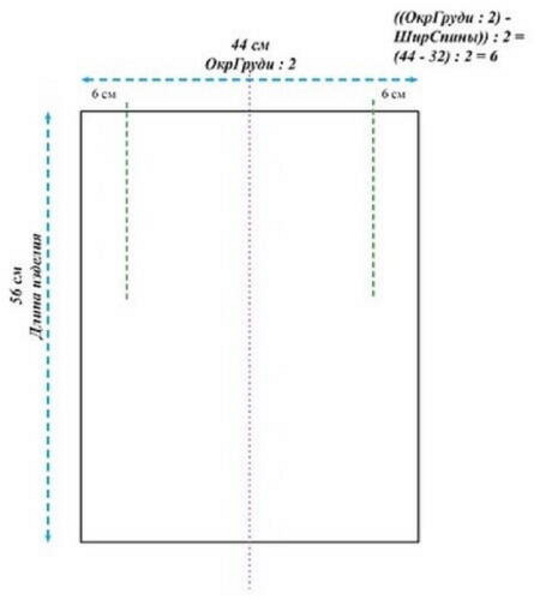
- Next, the armhole height is calculated.
- The “OG” measurement is divided by 6. Then 5 cm is added (88 cm / 6 + 5 = 19.5 cm).
- This number is rounded to 19.
- Then the extra stripes are removed and the armholes are designed with smooth lines.
- Before constructing the neckline lines, calculate the width of the collar on the back.
- It is equal to the value of "OS" divided by 3.
- It turns out 33 cm / 3 = 11 cm.
- The shoulder line is raised by 2 cm.
- Then the dots are connected with a smooth line and a new shoulder line is drawn.
Building a shelf
Technique of execution:
- The pattern for the shelf is made using the ready-made drawing of the back.
- In other words, this drawing is copied and folded in half.
- Then, in the middle of the shelf, mark a point below shoulder level at the distance planned for the neckline design.
- Then this point is connected to the shoulder slope with a smooth line.
Construction of the sleeve
Technique of execution:
- Draw a rectangle 55 cm high (measurement “DR”) and 32 cm wide.
- The value of “W” is calculated using the formula “OG” / 3 + 2 = 88 cm / 3 +2 = 31.3.
- Rounded up to 32 cm.
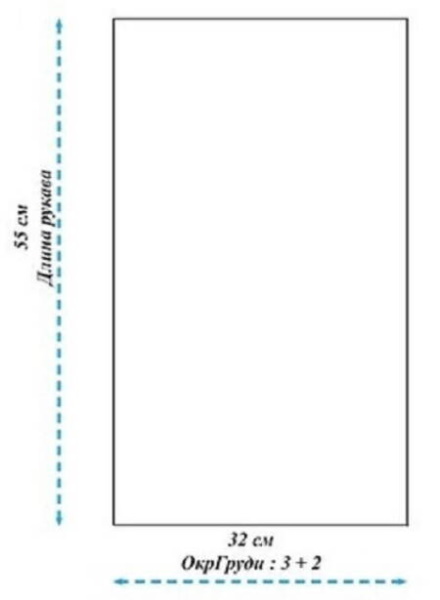
- The middle is marked on the sleeve.
- The height of the armhole is plotted on this line.
- Formula for calculation: "OG" / 8 +3 cm.
- With the available data – 88 cm / 8 + 3 = 14 cm.
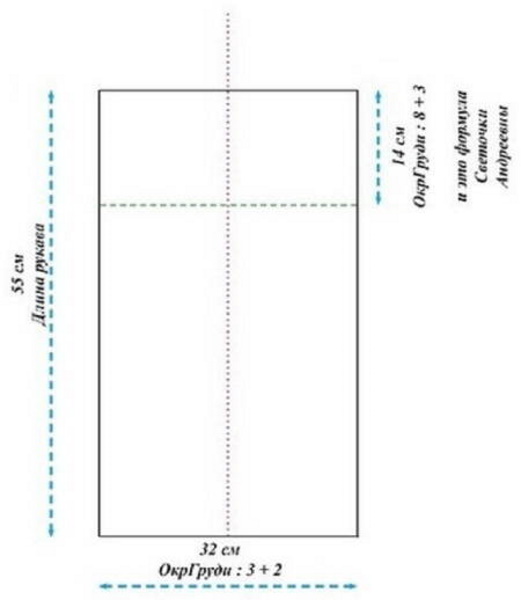
- Then the extreme side points of the armhole are connected with lines to the center of the top of the sleeve. Their middle is marked.

- They make a design on the sleeve of the lower line.
- From its center, on both sides, measure ½ of the distance, equal to “OZ” + 2 cm.
- The selected values are 18 cm + 2 cm = 20 cm.
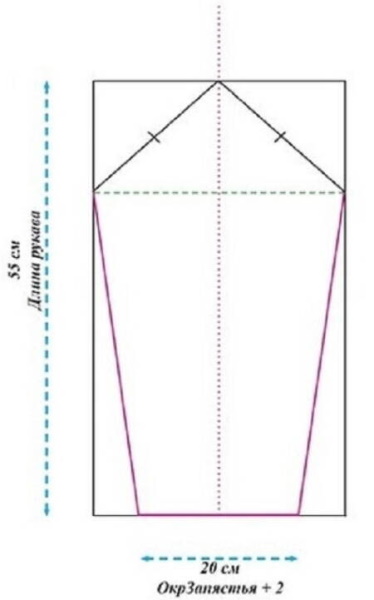
- All points are connected with smooth lines.
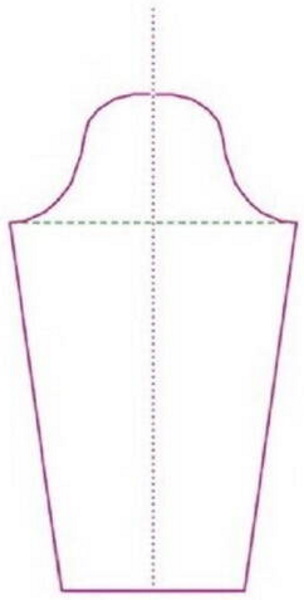
If the model is made with a straight armhole, constructing the jumper pattern is made much easier.
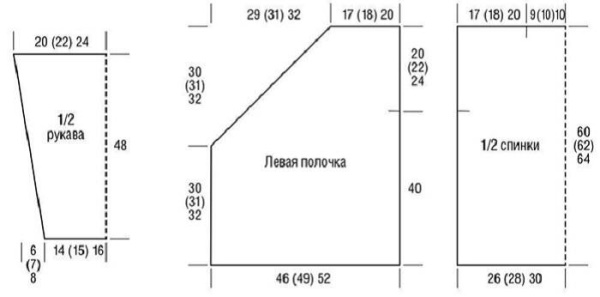
In this case, the armhole curves and sleeve caps are not constructed.
Conventional abbreviations and acronyms in master classes
Abbreviations:
| Name | Designation |
| p. | loop |
| nak. | yarn over |
| "plain elm." | garter stitch |
| persons. | face loops |
| kr. | circle |
| vm. | together |
| track. | next |
| out. | purl stitches |
| rap. | rapport |
| schematic | scheme |
| add. | additional |
| chrome. | edge loops |
| crossbreed | crossed |
| start | start |
| conn. st. | connecting post |
| "stocking elm." | stockinet |
Jumper with raglan top
A women's knitted jumper (diagrams and instructions for making the model will help you create a beautiful stylish item) knitted with a raglan and openwork sleeves looks very impressive.

You will need knitting needles and circular needles No. 5, yarn (DROPS) ALPACA (4-6 skeins - 50 g / 167 m, alpaca 100%), KID-SILK (3-5 skeins - 25 g / 200 m, mohair 75%, silk 25%). Knitting density: 17 sts and 22 rows = 10X10 cm.
Product dimensions:
- S;
- M;
- L;
- XL;
- XXL;
- XXXL.
Increases are made on the sides:
- Nak., 1 person, marker.
- Then again 1 person, nak.
- In the next round, yarn overs are knitted with purl crossed sts.
They subtract in this way:
- 1 st is slipped as if to knit, then 1 st is slipped. The slipped st is pulled over the knitted st.
- Next comes 1 knit, marker, 1 knit.
- 2 sts are knitted together as if they were knitted together.
The product is knitted from top to bottom. The beginning of the circle is the middle of the back. The sleeves are knitted in the round, using sock needles.
Yoke
Algorithm of actions:
- Cast on 82-86-90-94-98-102 sts.
- 4 rows perform "plait knitting".
- Continue knitting 12-13-14-15-16-17 persons., nak., 2 persons.
- Figure A.1 (sleeve = 13 sts) knit 2, yarn over, knit 24-26-28-30-32-34. Then yarn over, knit 2.
- Then knit again from 12 to 17 persons, as in point 3.
- In this row, add 8 sts.
- It turns out 90-94-98-102-106-110 p.
- Continue knitting according to pattern A.1.
- On each side of the 2 sts of stocking stitch add 1 st.
- New stitches are knitted according to the same pattern.
- In the next round, holes are formed from yarn overs.
- In every 2nd row add 8 sts.
- It turns out 21-24-25-28-32-36 rows = 250-278-290-318-354-390 sts.
- Then, when the vertical rapport is completed according to diagram A.1, repeat rap. AX (6 cr.).
- In the next row, the sleeve loops are transferred to additional knitting needles when all the increases have been made.
- Then cast on new 6-6-8-8-10-10 sts to make the sleeve undercuts.
- Markers are hung between them.
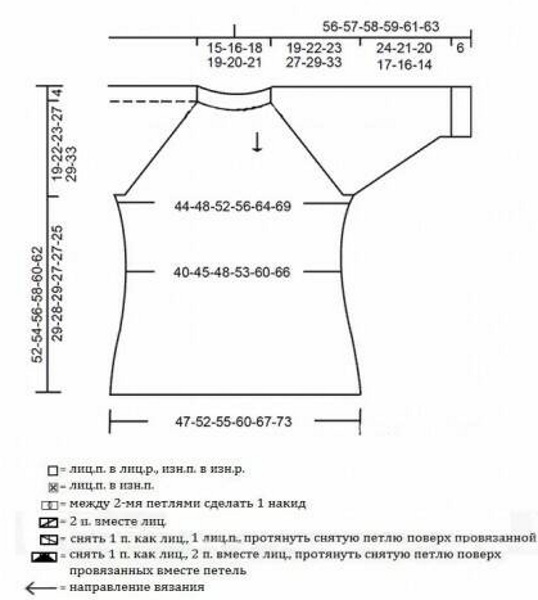
- The sweater is sewn along these points.
Main detail
Technique of execution:
- Dial 148-164-176-192-216-236 p.
- The fabric is knitted using stocking stitch.
- Then, after 3 cm, gradually decrease by 1 st.
- These decreases are made on both sides of the attached pins.
- Then the series of reductions is repeated again every 4-4-3-3-2 ½ cm.
- In 3 rows knit 136-152-164-180-204-224 sts.
- Then 1 st is added after 15-14-15-13-13-11 cm.
- It is added between the placed markers.
- Then there is an alternation: 2 cm are skipped, and then the row of additions is repeated again.
- Knit 160-176-188-204-228-248 sts.
- These stitches are knitted 6 times.
- 2 rows are knitted with a 2 X 2 elastic band through 28-27-28-26-26-24 cm.
- The loops are closed following the pattern.
Sleeves
Method of execution:
- The set aside sts are transferred to the sock needles.
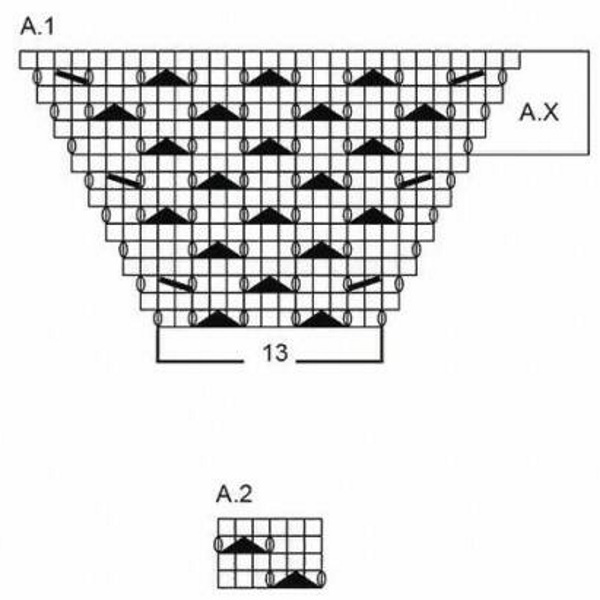
- Knitting begins from the center of the cut.
- Raise 3-3-4-4-5-5 sts.
- P. is knitted with a patterned ornament, following diagram A.2.
- Then, along the edge of the cut, raise another 3-3-4-4-5-5- sts.
- Place marker at beginning of row = 63-69-73-79-89-97 sts.
- Stitches that are not included in the A.2 rapport are knitted in stocking stitch.
- In the next row, knit the front stitches 24-21-20-17-16-14 cm from the circle.
- Decrease evenly 15-21-21-27-33-41 sts = 48-48-52-52-56-56 sts.
- Next, continue knitting with a 2 x 2 elastic band to a height of 6 cm.
- Finally, the loops are closed, observing the pattern = 30-27-26-23-22-20 cm – this is the length of the sleeve.
Thin cable knit jumper
A women's jumper with knitting needles (the patterns and description of this model are somewhat complex, but experienced needlewomen can easily knit such a product) is also knitted from thin yarn. The model is suitable for sizes 38-40 (42-44). You will need cotton yarn 400 (500) g, a set of circular and stocking needles No. 2.5, 3.

Patterns:
| Pattern | How to do it |
| Rubber | The number of sts is a multiple of 4 = alternately knit 2 knit, 2 purl. |
| Back side panel. elm. | Front and back rows are knitted only from the back.
|
| Openwork patterns "Braids" | 36 + 18 sts = knit only the front row, following the diagram.
In the purl row, all sts and yarn overs are knitted purlwise. 1st size: rap. always repeat. Finish st. before arrow. 2nd size: start with the final 9 sts of the rapport. Repeat the pattern all the time. Finish with the initial 9 sts. However, along the edge of the product, partial crossings are replaced by front sts. 1 – 48 p. constantly repeat. |
Density:
35.5 rows (27 sts) = 10 x 10 cm knitted with openwork pattern “braids”. The same number of rows, but 23 sts are knitted “purl garter stitch”.
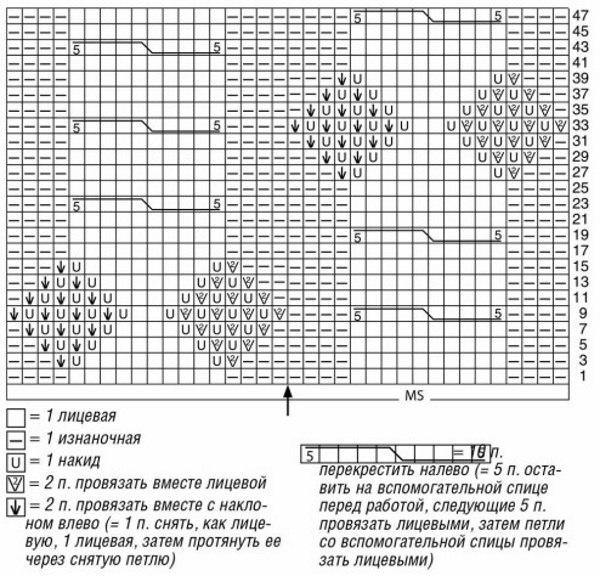
Back
Technique of execution:
- Cast on 126 (134) sts using 2.5 mm needles.
- Between the edges, knit 4 cm of elastic to make the bottom strip.
- In the final purl row, add 4 sts evenly = 130 (138) sts.
- Next, work with needles No. 3.
- Knit the edge, 1 (5) “purl garter stitch”.
- 126 sts are knitted with pattern 3, (1) 5 “purl garter stitch”, edge.
- After 52 cm = 184 rows from the bottom edge of the strip, close the middle 42 sts to make the neckline.
- Both sides finish separately.
- 1×3 sts and 1×2 sts are closed in every 2nd row to round off the inner edge of the piece.
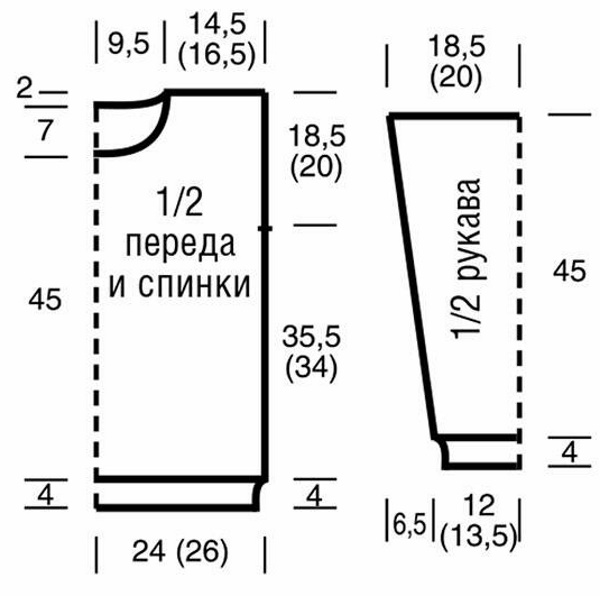
- The remaining 39 (43) sts of the shoulders are closed after 54 cm = 192 rows from the bottom bar.
Before
Sequence of actions:
- The detail is knitted like the back. However, it has a deeper neckline.
- Therefore, the central 32 sts are closed after 45 cm (160 rows) from the bottom bar.
- Next, in every 2nd row, close 1 x 3 sts, 1 x 2, 5 x 1 st.
Sleeves
Procedure:
- For each piece, cast on 66 (70) sts using 2.5 mm needles.
- 4 cm of elastic is knitted between the edges to make a strip.
- In the final purl row add 0 (4) sts = 66 (74) sts.
- Knitting with openwork from “braids” continues: first, knit 1 edge and 5 (9) last raps.
- Rap. is performed 1 time.
- Finish with 23 (27) initial rap sts and 1 edge st.
- The number of nak. and knitted together sts must match inside the pattern along the edge.
- On both sides of the strip, in every 10th row, add symmetrically 5 x 1 st to make the sleeve bevels.
- And in every 8th row add 12 x 1 st.
- Increases are made according to the pattern = 100 (108) sts.
- All loops are closed after 45 cm = 160 rows.
Assembly
Method of execution:
- Perform shoulder seams.
- Along the edge of the neck, cast on 128 sts using circular knitting needles No. 2.5 to make a piping.
- Then 1 circular row is knitted from the inside out.
- And the 11th row is knitted with an elastic band.
- Finally, all loops are closed, following the pattern.
- The seams of the parts are ground down.
- The sleeves are sewn in.
Jumper with English ribbing made of mohair yarn
Women's jumper with knitting needles (diagrams and step-by-step description of the product are suitable for knitting with mohair) in this version is knitted with English elastic. You will need mohair yarn 100 g / 500 m and a set of knitting needles No. 4.5. Pattern: double-sided elastic 1 x 1.

1st row – basic:
- Knit 1 edge, 1 front, remove the next st. purlwise together with the yarn over.
- Repeat this way throughout the row until the last 2 sts.
- The penultimate stitch is knitted with the front stitch and the edge stitch is purl (if there is an even number of stitches).
- The row is completed with a purl, removed from the yarn over and 1 edge stitch, if the number of sts is odd.
2nd row:
- Knit 1 edge stitch. Then 1 purl stitch.
- It is removed from the inside out.
- These 2 sts are knitted.
- Repeat until the end of the row.
- The final st is knitted purlwise, like the edge.
- Before the edge there can be a front stitch if there is an even number of stitches.
- All subsequent rows are knitted according to the description of the 2nd row.
Before you start knitting, knit a small sample. For example, cast on 25-30 sts and knit about 20 rows. Then draw a pattern for the future jumper. Indicate your measurements and calculate the number of loops based on the selected sample.
Back
Technique of execution:
- Knit on an even or odd number of sts.
- The required number of loops are cast on the knitting needles using any convenient method.
- Next, the fabric is knitted with English elastic to the required length. The pattern is not changed.
- To prepare the neck, close the middle 1/3 of all the cast-on sts.
- The shoulders are finished separately, knitting another 4-6 rows.

- Add another 5 p.
Before
Sequence of actions:
- The front part is knitted in a similar manner.
- However, the neck loops are closed a little earlier.
- These points are divided into 4 parts.
- First, close the central sts, and then the remaining sts in several parts.
Sleeves
Procedure:
- The sleeves are knitted symmetrically.

- Cast on the required number of sts and knit the pieces upwards.
- Add 1 st evenly every 10 cm.
Assembly:
- All the details of the product are sewn together. First, the shoulder seams are made. Then the sleeves are sewn on.
- Then the side seams are sewn together.
Colored oversized jumper for girls
The colored jumper has a variety of shades - from pastel tones to bright colors. Unusual color combinations only emphasize the beautiful patterns of the product. You will need circular knitting needles No. 10, 8 (length of the line 80 cm), skeins of yarn in orange/peach or salmon colors, as well as apricot shades.
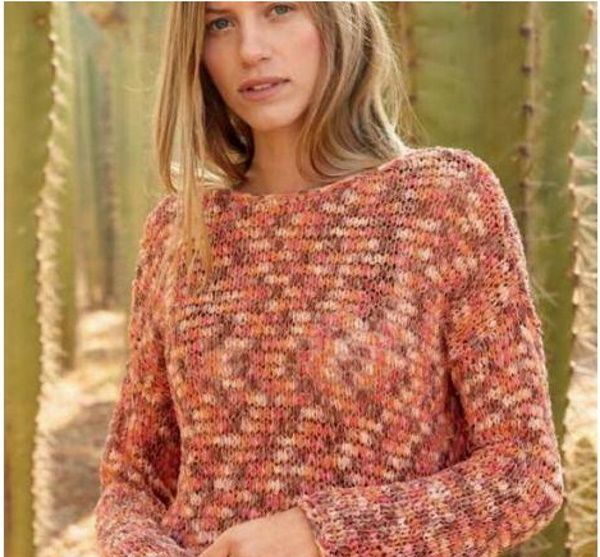
Knitting the knot edge:
- In rows, the first st is removed as knit stitch, and the final st is knitted as knit stitch.
- The edges of the elements are made knotty.
The product is knitted with the front surface.
The threads are changed periodically:
- Knit 1 row alternately with yarn of one and the other tone.
- The fabric is knitted using knitting needles with fishing line.
- 2 front rows alternate with 2 purl rows.
- The loops are constantly moved to the end of the needle during color changes.
Highlighted increases (side and sleeve bevels)
Technique of execution:
- At the beginning of the row, after the 2nd st, knit 1 front, crossed from the transverse thread.
- The same st is knitted before the last 2 sts at the end of the row.
Density: 11.5 cm (18 rows) = 10 x 10 cm. Needles No. 10.
Back
Sequence of actions:
- 56 (62) 66 sts are cast on using smaller diameter needles.
- At the beginning of 1 out. row knit. st.
- Then use knitting needles No. 10.
- The fabric is knitted with a satin stitch.
- The yarn is changed periodically.
- They knit a "knotted" edge.
- After 10 cm (row 19) from the initial row, on both sides for the bevels, make the designated increases 1 time.
- Then in every 12th row add 4 more times.
- It turns out 66 (72) 76 p.
- After 28 cm (50 rows) from the 1st increase, mark the beginning of the armholes.
- Then knit straight.
- Then also after 15 (19) cm = 28 (32) 34 rows from the beginning of the armholes, close 6 (7) 9 sts.
- Next, in every 2nd row, close another 2 x 7 (8) sts.
- Here, immediately with the 1st reduction, close the central 16 sts of the neckline.
- Both sides are finished knitting separately.
- Then, along the inner edge, close 1 x 3 sts, 1 x 2 sts.
- These actions are performed in every 2nd row to make further roundings.
Before
Procedure:
- This detail is knitted in the same way as the back.
- However, it has a deeper neck.
- From the beginning of the armholes through 12 (14) 16 cm = 22 (26) 28 rows, close the middle 8 sts.
- Both sides of the canvas are also finished separately.
- Then, again in every 2nd row, close another 1 x 4 sts, 2 x 2 sts, 1 x 1 st to round off the piece from the inner edge.

- The outer edges of the shoulder bevel are made according to the height of the back.
Sleeves
Sequence of actions:
- Cast on 30 (34) 38 sts using size 8 needles.
- Next, knit 1 purl row.
- Then they move on to knitting needles of a larger diameter.
- The details are knitted with front satin stitch, alternating the threads.
- Make a knotted edge again.
- After 15 cm (27 rows) from the initial row (on both sides), make the highlighted increases 1 time to knit the bevels again.
- Then in every 12th row add 3 more times.
- It turns out 38 (42) 46 p.
- After 25 cm (46 rows) from the 1st increase, close all loops.
Assembly
The details and seams are stitched. The neck is tied with a slip stitch using hook No. 8. The sleeves are sewn in.
A knitted jumper is a fashionable element of a modern women's wardrobe. To create such a product with your own hands, you will only need a pattern and a description for it.
Video on how to knit a women's jumper with knitting needles
Let's knit the most fashionable jumper with knitting needles:
